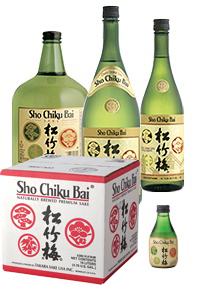Shochikubai SakeJunmai
|
Ginjo
Ginjo is a special type of Junmai or Honjozo, and considered the highest achievement of the brewer's art. All the rice employed in brewing Ginjo must be polished to at least 60% of its original size. Dai-Ginjo is brewed with the rice polished to at least 50%. In many Ginjo brewers use special yeasts in making Moto, and ferment the final mash very slowly at low temperature. This extra effort produce a sake that is lighter, clean taste and tangy flavor and an aroma.
Nigori
Nigori -"Cloudy"- sake is unfilterd or roughly filterd so that some Moromi in the fermenting tank make it into the bottle. This sake is a milky white appearance.
Nigori is bold and sweet taste.
SAKE TASTING
Purely Classic: Warm
You already may be accustomed to drinking sake warm in small porcelain cups (Sakazuki). Serving sake this customary way can add a special, traditional atmosphere to your enjoyment. To serve warm, pour sake into a small open mouthed carafe (Tokkuri). Heat it in a hot water bath over very low heat to approximately 110ƒF, about 5 minutes. Never boil sake, and usage of a microwave oven is not recommended. Both destroy aroma and flavor. Many sakes also may be served at room temperature.
Purely Contemporary: Chilled
Chilled sake is becoming increasingly popular as a versatile drink before, during and after meals. Traditionally only certain type of sake is chilled to enhance its delicate, unique flavor. While many of Takara's sakes may be served either at room temperature or chilled, some, including Ginjo type sake, were specifically developed for chilling. Chill sake to about 50ƒF. Serve it in an all-purpose wine glass just as you would a fine white wine. Once sake is opened, it should be stored in the refrigerator and drunk reasonably quickly.
HOW TO TASTE SAKE
The basic procedure of sake tasting is: look, smell, taste. Note appearance first, scent next, and finally palate. Kiki-choko, Japanese style tasting cup, is used in the sake tasting.
Appearance
Fill a cup with sake about 80% full. Check the cloudiness and color. If the contrasting lines between the blue and white of the cup are clear, the clarity of the sake is good. Ordinary sake have a light yellow tint or a light amber hue. Sake tends to get darker as getting older.
Smell
Smell, as same meaning as aroma, fragrance, nose and bouquet, is one of the most important elements in appraising sake. First bring the tasting cup closer to your nose and smell the "top" of the sake. Next, lower your nose into the cup to smell the "base" fragrance. Professional sake tasters use more than ninety words to describe the smell of the sake.
Taste
First, take a small quantity of sake and push it all around your mouth. After making sure that the sake has reached all the taste buds, then slowly breathe the air out through your nose. The aroma of the sake in your mouth will fill your nose, giving a much more intense impression of the smell and taste of the sake. Next, check the 5 tastes, sweet, dry, acidity, bitter and astringent, and the balance of them in the sake. Finally, swallow (or spit out) the sake in order to test "tail" of the sake.
Shochikubai Sake All Packages.
Want to see more items, please join to become the member. Thanks.

Plum Wine


